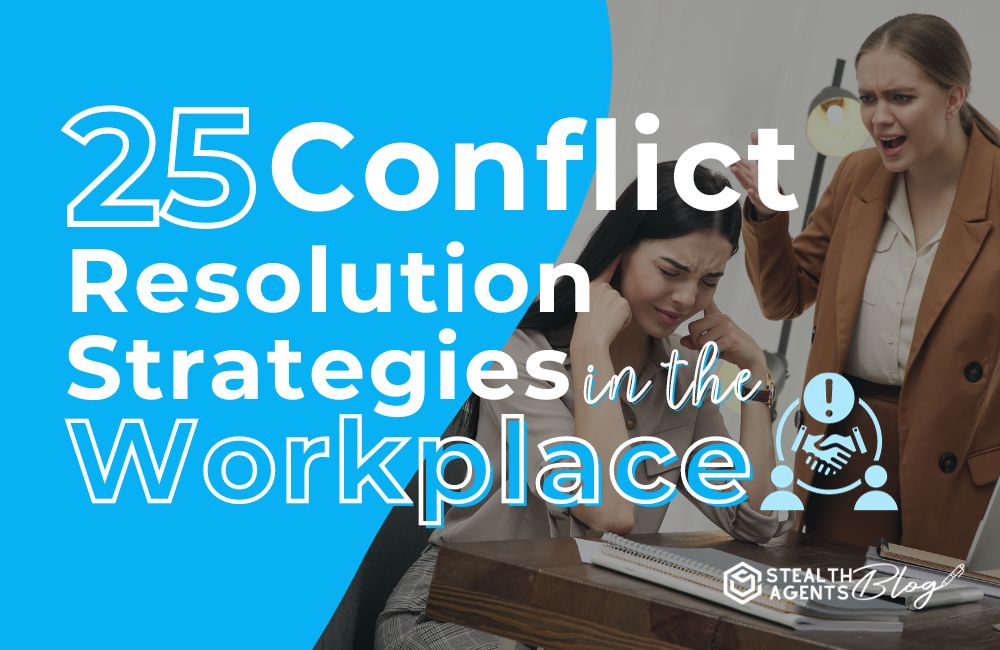Conflict resolution strategies in the workplace are crucial for maintaining a harmonious and productive environment.
With 85% of employees experiencing conflict, effective conflict resolution strategies are essential for business success. In a world where collaboration fuels innovation, conflict management strategies in the workplace can mean the difference between stagnation and growth.
Studies show that businesses adopting structured strategies to resolve conflict in the workplace witness a 67% improvement in team performance. To harness the full potential of your remote workforce, mastering conflict management essentials and utilizing team conflict management phrases for effective resolution and workplace conflict resolution phrases are imperative.
Discover how Stealth Agents’ virtual assistant can support your journey with free consultations on client preferences and virtual assistant pricing, ensuring a seamless path to resolution.
What are the Reasons for Conflict in the Workplace?
Conflict in the workplace is a common occurrence that can arise for various reasons, including differences in opinions, personalities, and work styles or even external factors such as competition for resources and promotions. These disagreements not only impact the morale and productivity of the individuals involved but can also affect the company’s overall efficiency.
Implementing conflict resolution strategies in the workplace is essential to address these issues effectively.
By adopting workplace conflict resolution strategies and conflict management strategies in the workplace, organizations can foster a more harmonious environment. Additionally, utilizing remote assistants or an online personal assistant can offer innovative approaches to resolve conflict in the workplace, ensuring smoother operations and enhanced teamwork.
1. Differences in Perspectives and Opinions
One of the leading causes of disagreement at work is having different ideas and points of view. When employees have differing views on how things should be done, it can lead to heated discussions and disagreements.
2. Personality Clashes
Conflict can also arise due to personality clashes. If individuals have conflicting personalities, they may find it challenging to work with others, leading to misunderstandings and conflicts.
3. Competition for Resources
In a competitive work environment, employees may need to compete with one another for resources such as budget, time, or recognition. This competition can create tension and conflict among team members.
4. Poor Communication
Miscommunication or lack of communication is a leading cause of conflict in the workplace. When there is a lack of clear communication, it can lead to misunderstandings, frustration, and ultimately conflicts.
5. Unfair Treatment
People may think their bosses or coworkers are treating them poorly, leading to anger and conflict.
What are the Ways to Resolve the Conflict?
- Identifying the root cause of a problem is crucial for effective problem-solving. By understanding the underlying issue, you can implement conflict resolution strategies in the workplace that lead to constructive solutions, fostering a harmonious and productive work environment for everyone involved.
- Effective communication is vital for resolving conflicts, especially when implementing conflict resolution strategies in the workplace. Encouraging open, honest dialogue among involved parties fosters an environment where everyone feels heard, understood, and respected, ultimately leading to harmonious and productive workplace relationships.
- Incorporating conflict resolution strategies in the workplace is vital for fostering mutual understanding between parties. By encouraging both sides to recognize each other’s perspectives and find common ground, it becomes easier to reach satisfactory and beneficial agreements for everyone involved.
- In some scenarios, utilizing conflict resolution strategies in the workplace can be enhanced by involving a neutral third party. This mediator plays a crucial role in bridging differences, addressing underlying tensions, and ultimately guiding the team toward a peaceful resolution.
- Organizations can enhance their conflict resolution strategies in the workplace by implementing comprehensive training programs, engaging in team-building activities, and robust conflict management policies. These initiatives foster communication, collaboration, and understanding, effectively preventing and managing conflicts to create a harmonious work environment.
Conflict resolution strategies
Here are the lists that can help you navigate through difficult situations and foster a positive working environment:
1. Acknowledge the conflict
Recognizing that a problem exists is the crucial first step in addressing it. If ignored or denied, the issue will escalate. Implementing effective conflict resolution strategies in the workplace is essential to prevent further complications and foster a harmonious environment.
2. Communicate effectively
To effectively implement conflict resolution strategies in the workplace, engage in open and honest dialogue, actively listen, and demonstrate respect. Strive to understand differing perspectives with empathy, fostering an environment where all voices are heard and valued, leading to harmonious resolutions.
3. Identify the root cause
Conflicts frequently indicate more profound, underlying problems within a team or organization. It’s essential to delve beneath the surface to identify and address these root causes, fostering a more harmonious and productive environment for everyone involved.
4. Focus on the present
Avoid revisiting previous disputes or grievances; instead, concentrate on addressing the current issue. Maintaining a forward-thinking approach to conflict resolution can foster a more harmonious environment and develop effective solutions that benefit everyone involved.
5. Take responsibility
Taking responsibility for your actions and offering a sincere apology when necessary can significantly de-escalate conflicts. This approach not only shows you are committed to resolving the issue but also helps reduce tension and fosters a more cooperative environment.
6. Use “I” statements
In conflict resolution, it is crucial to use “I” statements to express one’s own thoughts and concerns. This approach avoids blaming the other person and promotes a more constructive and empathetic dialogue that encourages understanding and cooperation between the parties involved.
7. Find common ground
In conflict resolution, identifying and focusing on areas of agreement can pave the way for a collaborative solution. By building on shared interests, both parties can work towards a resolution that satisfies everyone, fostering understanding, cooperation, and a harmonious working environment.
8. Take a break
When emotions escalate during a conflict discussion, taking a break allows both parties to cool down, preventing impulsive reactions. This pause provides time to reflect, fostering a calmer atmosphere and enhancing the likelihood of a more productive and respectful dialogue later.
9. Use humor
Humor can diffuse tension in conflicts by easing stress and fostering open dialogue. For instance, using light-hearted jokes or playful anecdotes can break the ice, making it easier to address issues while ensuring respect and maintaining a professional atmosphere.
10. Seek mediation
If you can’t resolve the disagreement on your own, consider involving a neutral third party. This person can facilitate open dialogue, help clarify misunderstandings, and guide you toward a mutually beneficial solution, enhancing communication and understanding between both parties.
11. Practice active listening
In conflict management, genuine attentiveness is crucial. Actively listening and repeating the other person’s words confirms your understanding and helps clarify any potential misunderstandings, fostering effective communication and conflict resolution.
12. Avoid personal attack
In conflict resolution, it is crucial to address the specific problem without resorting to personal attacks. This approach encourages open communication and mutual understanding, fostering a collaborative environment that leads to effective problem-solving while preserving positive relationships and ensuring a harmonious team dynamic.
13. Brainstorm solutions
Foster an environment where creative thinking thrives, encouraging team members to collaborate and brainstorm diverse ideas. By combining different perspectives and innovative approaches, we can collectively generate multiple solutions, ultimately leading to more effective conflict resolution and enhanced teamwork. This synergy drives success.
14. Set ground rules
When initiating a discussion, it is crucial to establish clear boundaries to ensure respectful communication and active listening. Unacceptable behaviors such as interrupting, using disrespectful language, or dismissing others’ opinions should be avoided to maintain a constructive and positive atmosphere for productive dialogue.
15. Use a problem-solving approach
In conflict resolution, it’s crucial to avoid assigning blame and instead emphasize collaborative problem-solving. By focusing on a solution that offers mutual benefits for everyone involved, relationships are strengthened, and outcomes are improved, fostering a more positive and productive environment.
16. Take a collaborative approach
In resolving conflicts, prioritize teamwork and collaboration to achieve a mutually beneficial solution. By working together rather than competing to win, you enhance team dynamics, promote understanding, and create a harmonious environment that leads to more effective and lasting resolutions.
17. Don’t make assumptions
Ineffective communication, seeking clarity by asking questions and gaining more information is essential. Avoid making assumptions about others’ intentions or actions. Understanding their perspective enhances relationships and facilitates more successful conflict resolution, leading to more harmonious interactions.
18. Use positive language
Opting for positive language over negative or accusatory words can transform interactions. This approach encourages constructive dialogue, diminishes defensiveness, and nurtures collaboration and understanding, leading to more effective and harmonious conversations and relationships.
19. Take breaks
During intense discussions, pausing and stepping back is beneficial. It allows both parties time to regain composure and reflect. This approach ensures that when the conversation resumes, it can proceed with a clearer mindset, facilitating more constructive and productive dialogue.
20. Practice empathy
In communication, it’s essential to practice empathy and strive to see the situation from the other person’s perspective. By genuinely understanding their feelings and viewpoints, interactions become more effective, fostering constructive dialogue and facilitating smoother conflict resolution, ultimately enhancing relationships.
21. Stay calm
Maintaining composure and steering clear of defensiveness or emotional reactions is vital during conflict resolution discussions. Staying calm allows for more effective communication, ensuring that dialogue remains constructive and focused on reaching a resolution that benefits all parties involved.
22. Find a win-win solution
In resolving conflicts, it is essential to delve into and address both parties’ underlying needs and interests. By doing so, solutions become more sustainable and satisfying, ensuring everyone’s desires are considered, ultimately leading to harmonious and enduring resolutions.
23. Focus on facts, not emotions
When addressing conflicts, it’s essential to prioritize objective facts over emotional reactions. Maintaining a factual approach makes communication more transparent and understanding deeper, and conflict resolution is achieved more effectively, leading to more constructive and harmonious interactions among all parties involved.
24. Use nonverbal communication
Body language plays a pivotal role in communication. Ensure your gestures are open and welcoming to enhance interactions by making others feel at ease and appreciated. This approach fosters a more effective, harmonious, positive communication environment, promoting mutual understanding.
25. Follow up
Once a resolution is achieved, following up with the other person is essential to confirm both parties are content with the outcome. This proactive step helps prevent the issue from resurfacing, ensuring ongoing harmony and relationship stability.
Takeaways
Navigating conflict in the workplace is inevitable, yet effective conflict resolution strategies can transform these challenges into opportunities for growth. By embracing these 25 workplace conflict resolution strategies, teams can cultivate a more harmonious and collaborative environment—these conflict management strategies in the workplace aid in resolving disputes and strengthening relationships among colleagues.
As you integrate these strategies to resolve conflict in the workplace, expect to see enhanced communication, elevated productivity, and a more positive workplace culture. Remembering that each conflict is unique and identifying the right approach is crucial for successful resolution. With the appropriate strategies to resolve conflict in the workplace, disagreements can evolve into constructive dialogues.
Adopting these methods empowers your team to handle disputes with confidence and professionalism.
For organizations aiming to boost their conflict management skills, virtual assistants from Stealth Agents offer tailored solutions to streamline the resolution process and drive your team toward success.












